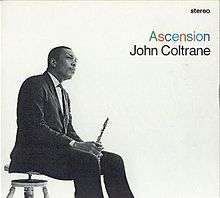Ascension (John Coltrane album)
| Ascension | ||||
|---|---|---|---|---|
 | ||||
| Studio album by John Coltrane | ||||
| Released | February 1966[1] | |||
| Recorded | June 28, 1965 at Van Gelder Studio, Englewood Cliffs | |||
| Genre | Free jazz, avant-garde jazz | |||
| Length |
40:49 (Edition II) 38:30 (Edition I) 79:19 (CD release) | |||
| Label | Impulse! | |||
| Producer | Bob Thiele | |||
| John Coltrane chronology | ||||
| ||||
| Professional ratings | |
|---|---|
| Review scores | |
| Source | Rating |
| Allmusic | |
| The Penguin Guide to Jazz | |
| Rolling Stone Album Guide | |
| The Rolling Stone Jazz Record Guide | |
Ascension is a jazz album by John Coltrane recorded in 1965 and released in 1966. It is often considered to be a watershed album, with the albums released before it being more conventional in structure and the albums released after it being looser, free jazz inspired works. In addition, it signaled Coltrane's interest in moving away from the quartet format. Coltrane described Ascension in a radio interview as a "big band thing", although it resembles no big band recording made before it. The most obvious antecedent is Ornette Coleman's octet (or "double quartet") recording, Free Jazz: A Collective Improvisation, which—like Ascension—is a continuous 40-minute performance with ensemble passages and without breaks. Jazz musician Dave Liebman, commenting on Ascension, recalled that the album was the "torch that lit the free jazz thing".
Music
Coltrane's horn section is moored to a monolithic rhythm section, centered on pianist McCoy Tyner, double bassists Jimmy Garrison and Art Davis, and drummer Elvin Jones. On Ascension (and unlike on Coleman's Free Jazz), group ensembles alternate with solos, and take up about equal space. The basic theme stated in the opening and closing ensembles is a variation on the major motif of Coltrane's previous album A Love Supreme (1965), particularly the opening bass riff stated on said album's opening track, "Acknowledgment".
Coltrane gave the musicians no directions for their solos, other than that they were to end with a crescendo. The ensemble passages are more structured. There were chords, but apparently they were optional; it is more accurate to say that the ensembles consist of a progression of modes rather than chords, with mode changes signaled by Coltrane, pianist McCoy Tyner, and trumpeter Freddie Hubbard. By comparison to Free Jazz, Ascension features a much expanded "front line", with two altos, three tenors, and two trumpeters.
The horn section consisted mostly of younger players, most of whom would soon attain some degree of fame on the (free) jazz scene. A notable exception is trumpeter Dewey Johnson, who plays the first solo of the album after Coltrane. Plagued by mental illness, Johnson never made another professional recording (he had played previously on Paul Bley's 1964 album Barrage), eventually disappearing in New York City in the 1980s. He currently resides in Coler Specialty Hospital and Nursing Home on Roosevelt Island in New York City. Because of Johnson's obscurity, and his prominent place on the album, his solo is sometimes mistaken for Hubbard's.
Order of soloists and ensembles
The solo order differs slightly between the takes; Edition II also features no drum solo by Elvin Jones.
|
|
Track listing
Two recordings of "Ascension" exist, called Edition I and Edition II. Edition I is the second recorded take of the composition and was originally released on Impulse in February 1966 (catalog number A-95). Because of vinyl limitations, it was divided into two parts. Edition II is the first take and Coltrane's preferred version. It replaced Edition I (also as A-95, with "EDITION II" etched on the vinyl runout circle[6]) some months after the original release. Both versions are available on the CD version first released by Impulse in 2000.[7]
- Edition I
"Ascension" (John Coltrane) – 38:30
- Edition II
"Ascension" (Coltrane) – 40:49
Personnel
- Freddie Hubbard – trumpet
- Dewey Johnson – trumpet
- Marion Brown – alto saxophone
- John Tchicai – alto saxophone
- John Coltrane – tenor saxophone
- Pharoah Sanders – tenor saxophone
- Archie Shepp – tenor saxophone
- McCoy Tyner – piano
- Art Davis – bass
- Jimmy Garrison – bass
- Elvin Jones – drums
References
- ↑ Billboard Feb 5, 1966
- ↑ Allmusic review
- ↑ Cook, Richard; Morton, Brian (2008). The Penguin Guide to Jazz Recordings (9th ed.). Penguin. p. 291. ISBN 978-0-141-03401-0.
- ↑ All Music Guide Info and Review.
- ↑ Swenson, J. (Editor) (1985). The Rolling Stone Jazz Record Guide. USA: Random House/Rolling Stone. p. 47. ISBN 0-394-72643-X.
- ↑ "John Coltrane – Ascension (Edition II) (Vinyl, LP, Album) at Discogs". Discogs. Retrieved August 19, 2011.
- ↑ Ascension (CD insert, CD back cover). John Coltrane. Impulse. 2009. 0602517920248.
Sources
- Kahn, Ashley. A Love Supreme: The Creation of John Coltrane's Classic Album, Granta Books, paperback 2003, ISBN 1-86207-602-2